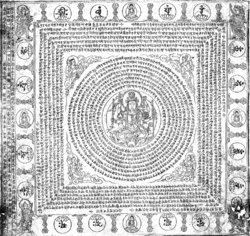Philosophy:Dhāraṇī
A Script error: The function "transl" does not exist. (Devanagari: धारणी) is a Sanskrit term for a type of ritual speech similar to a mantra.
Etymology and purpose
The word dhāraṇī derives from a Sanskrit root √dhṛ meaning "to hold or maintain".[1]
Ryuichi Abe and Jan Nattier suggest that a dhāraṇī is generally understood as a mnemonic which encapsulates the meaning of a section or chapter of a sutra.[2] Dhāraṇīs are also considered to protect the one who chants them from malign influences and calamities.
Dhāraṇīs and mantras
Kūkai
The Japanese Buddhist monk Kūkai drew a distinction between dhāraṇī and mantra and used it as the basis of his theory of language. Kūkai claims that mantra is restricted to esoteric Buddhist practice whereas dhāraṇī is found in both esoteric and exoteric ritual.
Kūkai classified mantras as a special class of dhāraṇīs and argued that every syllable of a dhāraṇī was a manifestation of the true nature of reality – in Buddhist terms, that all sound is a manifestation of śūnyatā or emptiness of self-nature. Thus, rather than being devoid of meaning, Kūkai suggests that dhāraṇīs are in fact saturated with meaning – every syllable is symbolic on multiple levels.
Scholarship
According to Red Pine, mantra and dharani were originally interchangeable, but at some point dhāraṇī came to be used for meaningful, intelligible phrases, and mantra for syllabic formulae which are not meant to be understood.[3] Jan Nattier writes that, whereas mantra has ancient Hindu usage back to the Vedas, dhāraṇī does not predate Buddhism.[4]
According to Taiko Yamasaki, a dharani is a long mantra, while a shorter mantra is called a "vidya". [5]
See also
- Ye Dharma Hetu
- Nīlakaṇṭha Dhāraṇī
- Uṣṇīṣa Vijaya Dhāraṇī Sūtra
- Cundī Dhāraṇī
References
Sources
- Braarvig, Jens (1985). Dhāraṇī and Pratibhāna: Memory and Eloquence of the Bodhisattvas, Journal of the International Association of Buddhist Studies 8 (1), 17-30
- Nattier, Jan (1992). 'The Heart Sūtra: A Chinese Apocryphal Text?', Journal of the International Association of Buddhist Studies 15 (2), 153-223
- Red Pine. The Heart Sutra: The Womb of the Buddhas (2004) Shoemaker & Hoard. ISBN:1-59376-009-4
Further reading
- Buswell, Robert Jr; Lopez, Donald S. Jr., eds (2013). Princeton Dictionary of Buddhism.. Princeton, NJ: Princeton University Press. pp. 241-242. ISBN 9780691157863. https://books.google.de/books?id=DXN2AAAAQBAJ&pg=PA226&lpg=PA226&dq=dharani+saddharmapundarika&source=bl&ots=c6nKrz5OjF&sig=AhPXyen_lacwei-17fT6qufOK_8&hl=de&sa=X&ei=W-VyVdi0BYObsAG-s5agCw&ved=0CFsQ6AEwCTgK#v=onepage&q=dharani%20saddharmapundarika&f=false.
- Davidson, Ronald M. (2009). Studies in Dhāraṇī Literature I: Revisiting the Meaning of the Term Dhāraṇī, Journal of Indian Philosophy 37, 97-147
- Davidson, Ronald M. (2014). Studies in Dhāraṇī Literature II: Pragmatics of Dhāraṇīs, Bulletin of the School of Oriental and African Studies 77, 5-61
- McBride, Richard, D., Dharani and Spells in Medieval China, Journal of the International Association of Buddhist Studies 28 (1), 85-114, 2005


